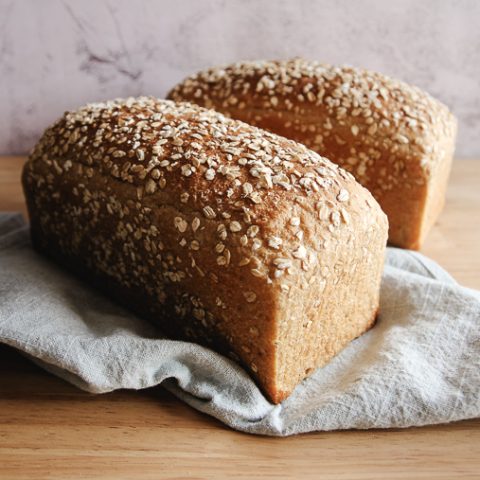Maple Oat Sourdough Bread
4.8
(5)
Your folders
Your folders
Prep Time: 35 minutes
Cook Time: 45 minutes
Total: 9 hours, 35 minutes
Servings: 2
Author : Leanna Aberle

Ingredients
Export 6 ingredients for grocery delivery
Instructions
Step 1
Autolyse flour and prepare oat porridge: Add 550g water, flour, and maple syrup to the bowl of a mixer fitted with a dough hook. Mix on low speed until all the dry flour is absorbed. Cover and allow to rest at room temperature for 1 hour. Meanwhile, mix 65g quick oats with 150g water in a cereal bowl and microwave for 1 minute on high (or cook on the stove in a small pan). Cover and set aside to cool.
Step 2
Mix: To the autolysed flour mixture, add the cooled oat porridge, ripe starter, olive oil, and salt. Mix on low speed until well combined.
Step 3
Knead: Knead on low speed for 5 minutes to start (use a higher speed only if your mixer is lagging). If dough has cleaned itself off bowl by this time, add 10 more grams of water (if sticking at all to the mixing bowl, do not add additional water!). Mix until the dough comes back together. If dough continues to clean itself off the bowl, add another 10 grams of water and knead to combine. I usually stop at 570g of water as long my dough feels loose and extensible like it could begin sticking at any moment, but is still able to keep its structure and clean itself off the sides of the mixing bowl. Knead for a few more minutes until the dough can be pulled to a thin windowpane with damp fingers.
Step 4
Bulk ferment: With damp hands, remove the dough from the mixer, form into a ball, and place into a large bowl or Cambro container for bulk fermentation. Cover and leave at room temperature until dough has doubled in volume. (Bulk took me 5 hours, 15 minutes with a final dough temp of 74°F and an ambient temp of 69-77°F. It will take longer if your dough/room temp is cooler.)
Step 5
Divide and shape: Grease two small loaf pans or small pullman pans with olive oil or softened butter. Turn out the dough onto a lightly floured surface (do not degas) and divide in half (can weigh dough, if desired). To shape the first loaf: pull the right and left sides of dough over each other like a sideways letter. Then gently roll the dough into a cylinder shape from the top or bottom (an unfolded edge) to form a loaf. Repeat to shape second loaf. To top with oats: Pat the tops and sides of loaves with a little water to dampen. Sprinkle quick oats in an even layer on the countertop, then gently roll the loaves through the oats, using a bench scraper in your dominant hand to help you lift and roll the loaves. Place the loaves top-sides-up in the greased pans (do not press loaves down).
Step 6
Proof: Cover pans with plastic wrap and set in a warm place to proof until the dough passes the poke test (dough should rise just shy of the rims of pullman pans, but will need to rise an inch above the rims of standard loaf pans). Meanwhile, preheat oven to 425°F with a rack set in the center. (Proofing took me nearly 2 hours with an ambient temp of 77°F.)
Step 7
Bake: Remove plastic wrap. Bake together on the same rack at 425°F for 15 minutes, then without opening the oven door, lower temp to 375°F and continue baking for 30 more minutes. Internal temp of loaves should reach at least 200°F when fully baked. Place pans on a cooling rack, then turn out loaves after 10 minutes or so. Cool completely before slicing or storing. Bread stores well wrapped at room temperature for up to 3 days or can be frozen whole or sliced.